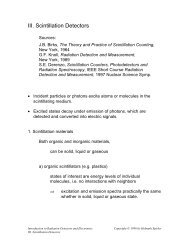Introduction to radiation-resistant semiconductor devices and circuits
Introduction to radiation-resistant semiconductor devices and circuits
Introduction to radiation-resistant semiconductor devices and circuits
You also want an ePaper? Increase the reach of your titles
YUMPU automatically turns print PDFs into web optimized ePapers that Google loves.
OUTPUT NOISE VOLTAGE DENSITY [μV/√Hz]<br />
0.15<br />
0.10<br />
0.05<br />
0.00<br />
post-rad<br />
pre-rad<br />
1E+5 1E+6 1E+7 1E+8<br />
FREQUENCY [Hz]<br />
FIGURE 5. Noise of a bipolar transis<strong>to</strong>r preamplifier before <strong>and</strong> after ir<strong>radiation</strong> <strong>to</strong> a<br />
fluence of 1.2⋅10 14 cm -2 (800 MeV pro<strong>to</strong>ns).<br />
Figure 4 shows measured DC current gain for npn <strong>and</strong> pnp bipolar transis<strong>to</strong>rs<br />
irradiated <strong>to</strong> a fluence of 1.2⋅10 14 cm -2 (800 MeV pro<strong>to</strong>ns). (26) These <strong>devices</strong>,<br />
fabricated in AT&T’s CBIC-V2 high-density complementary npn-pnp IC process,<br />
exhibit fT = 10 GHz for the npn <strong>and</strong> 4.5 GHz for the pnp transis<strong>to</strong>rs. In the CAFE<br />
chip designed for the ATLAS silicon tracker (29) the npn input device is operated<br />
at a current density of about 2 μA/(μm) 2 , where the post-rad current gain<br />
decreases <strong>to</strong> about 60% of its initial value. Although a smaller transis<strong>to</strong>r would<br />
deteriorate less, the thermal noise contribution of the parasitic base resistance<br />
would be excessive, so a compromise is necessary. No measurable changes in<br />
transconductance were measured, as expected. The output resistance of these<br />
<strong>devices</strong> decreased by





